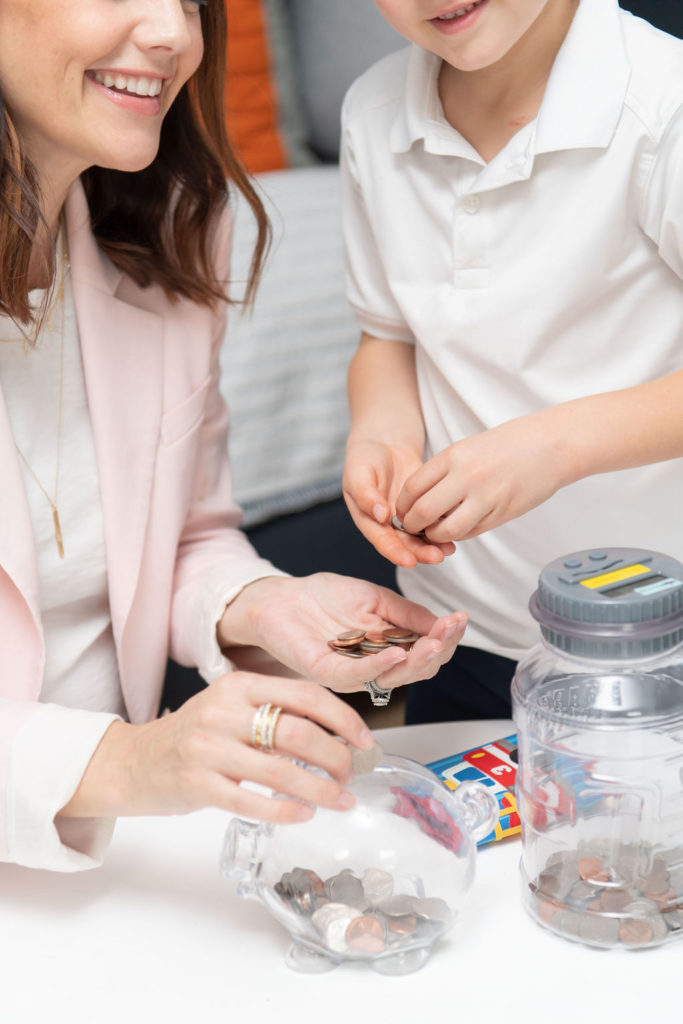
Raising financially smart children in today’s modern technology can be a challenge, but it is never too early to start talking to your children about money. With apple watches and venmo it’s easy for children to think money is easy to access and always available, but today I am partnering with Independent Community Bankers of America to share with you 6 smart tips to teach your children financial responsibility.


Practice Smart Finances Yourself
Like all things in life, children learn about financial responsibility best by seeing their parents model good behavior. When you are going to the bank to make a deposit or withdrawing cash from the ATM, talk to your children about why you are doing what you are doing. Speak in easy ways for them to understand like, “I am depositing some of the money I earned from work this week into a savings account for your college. We always set aside some money and never spend everything we make. It’s important for mommy and daddy to have a piggy bank for our future, just like your piggy bank. Except we keep our money at the bank.”


Encourage Entrepreneurial Opportunities:
Encourage your children to pursue entrepreneurial opportunities and make it a priority to make it a learning experience for them. This summer we hosted a lemonade stand on our street. I took the boys to the grocery store to buy everything we would need for the stand: lemons, cups, poster board, ice, etc. and explained to them that these were our ‘start up expenses’. To earn a profit you have to make more than we spent. After we came home and made the posters and homemade lemonade, we set up in the front yard to sell our product. The boys had so much fun working the stand and watching their jar fill up with money.

When they receive or earn money, make them put aside some for the future.
When we were all sold out of lemonade, we came inside to count their earnings. They had to pay back the grocery store bill (the cost of the lemonade stand) and then we divided the money into three piles: spend, save and donate. We wanted the boys to understand that you don’t get to spend everything you make. Some of your profits will need to go to savings in case there is something you need or want down the road (piggy bank), and another percent of your profits need to go towards helping others. Their Sunday school class collects an offering every Sunday so they use their “give” money to take to church on Sundays. The rest of their profits could go in their wallet to spend on something they wanted for themselves.


Use a Clear Piggy Bank or Jar for Savings:
When you use a clear jar, they can see their money filling up as they add to it. What started out as a few loose coins is now filling up and turning into dollar bills! Talk through this with them and make a big deal about how each little amount they save really adds up. Our boys got these clear money jar counters for Christmas and it is really cool to see it add the money as you add your change. What looks like a pile of coins quickly becomes $10 or more!

Show them that things Cost Money and Teach them About Opportunity Cost:
Instead of just commenting on the price of an item, help them to understand the meaning of a dollar by physically taking their money to the store. Let them count how much they have to spend, shop for an item in their budget and then physically hand the money to the cashier. This helps them see and understand the value of their hard earned dollar. It’s also important to always discuss their opportunity cost when they are spending their money. Remind them before they choose to buy something, “If you buy this car, then you won’t have the money to buy that stuffed animal you wanted.” As they get older, your kids should be able to weigh decisions and understand the possible outcomes before making a decision.

It’s never too early to Open a Bank Account
Teaching financial literacy to children from a young age can even include a trip to your local community bank. It is a wonderful idea to open a savings account or a 529 College Savings Account with your children present so you can talk about why it is important to start saving now and get them comfortable at the bank and speaking with the bankers. Local community banks are a wonderful place to start these relationships because the people who work there are often people the children are familiar with (from community events). Community Banks comprise 99% of all banks and have more than 50,000 locations nationwide. Most importantly, they have a net satisfaction score of 79% – higher than that of the nation’s largest banks and online lenders. (You can find a community bank near you by clicking here.) They are also the most likely to really take the time to sit with your children and help them understand the basics of compound interest and the importance of starting to save early. Plus, they always have lollipops available for a treat at the end! 😉


Have you started working with your young kids on financial responsibilities? I would love to hear some of your favorite tips and tricks in the comments below to share with me and the other readers!
If you would like more information about community banks and financial guidance, you may sign up for emails from ICBA here.
This post is sponsored by the Independent Community Bankers of America. Thank you for supporting the brands and partners who help make HOUSE of HARPER possible. To find a community bank near you, click here










Awesome ideas and post! Never to early to teach life skills!
Thanks for the tips! This was helpful.